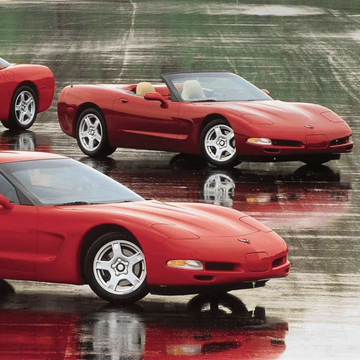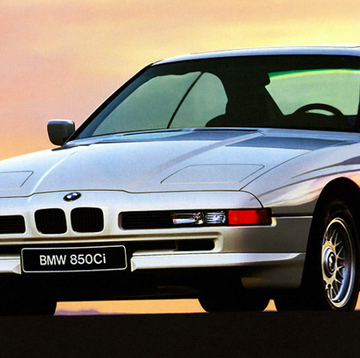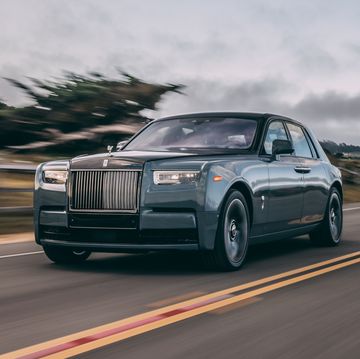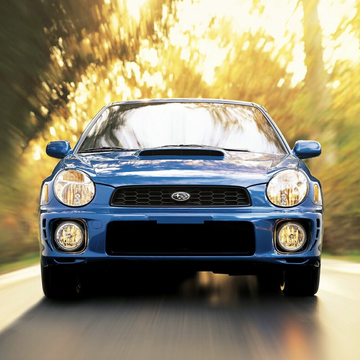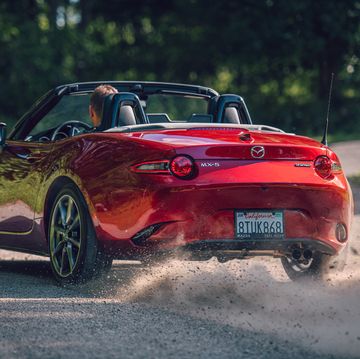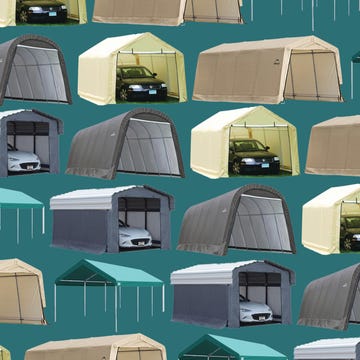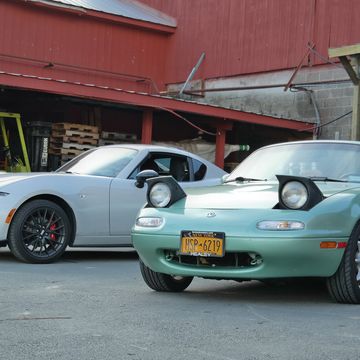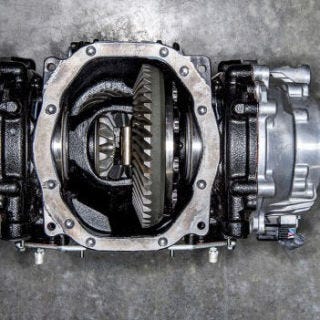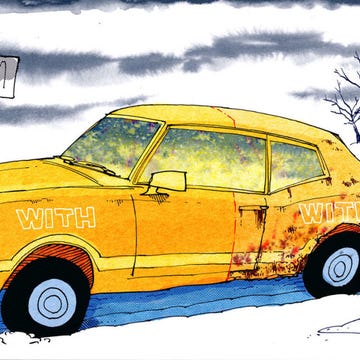The original 8-Series is one of BMW’s coolest cars. The company’s range-topping flagship throughout the Nineties, its iconic “sharknose” shape, pillar-less silhouette, and world-class powertrain solidified the car as an all-time great in the hearts of many enthusiasts. Though wildly expensive when new, prices for the E31-generation 8-Series have fallen to tantalizingly low levels, meaning pretty much anyone can own one.
Thinking about picking up an 8-Series of your own? You’re making a good choice. Here’s how to pick the right one.
The Ultimate Grand Tourer
Development of the 8-Series began in the mid-Eighties, with the car unveiled in production form at the 1989 Frankfurt Auto Show for the 1991 model year. According to Automobile, BMW sunk a full $900 million into the car’s design, which isn’t exactly surprising considering all of the clever engineering onboard. The handsome coupe’s low-slung front end and pop-up headlights meant an impossibly low drag coefficient of 0.29, while adjustable suspension, frameless door windows, and multiple computing systems added up to provide an unmatched driving experience. The car was wildly popular upon its arrival, with thousands of deposits taken in the week following its unveiling.
Under the hood of the car's launch trim, the 850i, sits BMW’s first production V-12, the M70. Borrowing much of its basic design from the company's 2.5-liter M20 straight-six, the 60-degree all-aluminum engine displaces 5.0 liters, and was rated at 296 horsepower and 332 lb-ft of torque when new, with a redline of 6000 rpm. Buyers had a choice between a six-speed manual transmission or a four-speed automatic. The 850i was the first production vehicle to pair a six-speed manual transmission to a V-12 engine, and one of BMW's first cars to utilize a multi-link rear suspension.
BMW developed a 6.0-liter, 640-horsepower version of the first-gen 8-Series called the M8, but unfortunately, never put it into production (just one prototype was built). Instead, the world received the 850CSi in 1992. A sort of ‘M8-lite,’ it had a host of performance-minded upgrades separating itself from the 850i, but lacked many of the extreme parts from the would-be M8. The engine, now called the S70B56, grew to 5.6 liters and received a higher compression ratio, rated from the factory at 372 horsepower and 402 lb-ft of torque when new. It also got a specific bodykit, staggered wheels, quicker steering, and stiffer suspension tuning. A six-speed manual was the only choice of transmission. Back when we tested it new, we were able to pull out a 0-60 time of just 5.9 seconds, and praised its smooth handling prowess and impressive brakes.
Around the same time the CSi was introduced, the standard 850i was renamed the 850Ci (with C standing for Coupe), to better align with the rest of the company’s corporate naming structure. In 1994, BMW gave the 850Ci a slightly bigger engine called the M73. Displacement jumped to 5.4 liters, rated at 322 horsepower and 361 lb-ft when new. Meanwhile, the automatic transmission went from a four-speed to a five-speed unit.
In order to give 8-Series buyers a cheaper, more efficient option versus the V-12, BMW added an 840Ci to the lineup in 1993. Under the hood of early models is an M60 4.0-liter V-8 making 282 horsepower and 295 lb-ft of torque, sending power to the rear wheels via a five-speed automatic gearbox. Unlike the 850, no manual option was offered on the 840Ci for North America. Two years later, the V-8 would grow in displacement to 4.4 liters thanks to a new M62 engine, retaining the same horsepower rating but receiving a jump in torque, to 310 lb-ft.
Though BMW never made a convertible version of the E31 8-Series, several aftermarket companies have offered conversions over the years for those looking for the ultimate drop-top grand-touring experience—though seeing one for sale is extremely rare. Similarly, German tuner company Alpina offered its own modified variants—the B12 5.0 and the B12 5.7—which included a handful of desirable cosmetic and mechanical upgrades.
So Which One Is Right for Me?
Which 8-Series is best for you depends heavily on what you plan to use it for, and how much you want to spend. Prices can range from under $5000 for clapped-out, abandoned project cars to well over $100,000 for pristine, collector-grade 850CSis and Alpinas.
Planning on getting into the 8-Series game as affordably as possible? You’re going to want to look for an early 850i. The base 12-cylinder cars are by far the most common—nearly two-thirds of all E31 8-Series sold were 850is and 850Cis. The cheapest variants are the first-, second-, and third-year cars with the smaller, simpler M70 engine. Unless you get lucky, you’ll likely have to settle for a car with the four-speed automatic transmission—manual cars are much rarer, and the unique 560G six-speed gearbox is a highly desirable option that, in some cases, can triple the value of the car. Expect to pay around $7000-$9000 for the cheapest running examples, and closer to $20,000 for the cheapest manual cars.
If you’d rather own a later 850Ci with the bigger engine, plan to spend a bit more. In addition to being more powerful, they’re also a fair bit less common than the 850i. And despite having less power and less cylinders, the 840Ci also demands a premium over the 850i in most cases, again due to its rarity.
Most collector-types will be satisfied with any manual 850—less than 900 examples were imported to the U.S.—but if you’re looking for something with even more prestige, it’s the 850CSi or either of the Alpinas you should be after. Only 225 CSis were ever brought to America, and in good running condition, could change hands for over $100,000 depending on mileage, options, and originality. Five of the 18 CSis sold on Bring a Trailer as of this writing have gone for over the six-figure mark. Conversely, driver-level cars with high miles can sell for as little as $45,000. Whether the car’s rarity, prestige, and slew of upgrades is worth the hefty price increase over a standard 850i or 850Ci is up to you.
If you really need to stand out amongst the 8-Series crowd, it’s either of the Alpina B12s you want. The 5.7 model, based on the 850CSi, is considered the pinnacle of the E31 platform. Its 416-horsepower engine is bored out to 5.7 liters and sports a new intake manifold, crankshaft, camshafts, and a free-flowing exhaust system. There’s also a specific Alpina body kit, graphics, wheels, interior trim, and a centrally located NACA duct on the hood. The 0-60 sprint happens in under six seconds, and top speed is 186 mph. Only 57 examples exist worldwide, and as you can imagine, they’re extremely valuable. This one sold for over $300,000 at auction in February 2020. The less desirable (but still extremely cool) 5.0 model uses the 850i as a base, but gets new engine internals to boost output to 350 horsepower. Just 97 of them were built, and clean examples like this one can easily sell for six figures.
So What Should I Look Out For?
Being a 30-year-old luxury German car, the original 8-Series has its fair share of well-known reliability issues. Some are more important than others, so it’s best to make sure you know what you’re looking for when you go to buy one yourself.
The E31’s V-12 might seem intimidating, but if you’re familiar with old BMWs, most of the hardware should be familiar. The engine isn’t terribly complex; it doesn’t use the company’s infamous VANOS variable valve timing system, only has two valves per cylinder, and has a robust timing chain rather than a belt. But it’s not perfect. The throttle bodies mounted to each intake manifold are known for failing, and cost a lot of money to replace. Similarly, seals can dry out over time and cause oil leaks around the bottom of the motor, or vacuum leaks throughout the intake system. The V-8 engines are even more prone to oil leaks, so keep that in mind if you haven’t yet decided which trim to look for.
On the original 8-Series, the most severe issues will make themselves known if the car is left sitting. The two fuel pumps, which are mounted inside the gas tank, will quickly go bad, along with the complex (and expensive) bracket that holds them together. The rubber in the engine bay will dry out, causing cracks and leaks in the cooling, oiling, and fueling systems. Most importantly, the car’s electrical components—of which there are many—will begin to malfunction or fail altogether. If you’re considering buying an E31 that’s been sitting for more than a couple of years, be prepared to spend a lot of time and money restoring it to its former glory.
Regular maintenance on the E31 is pretty straightforward, with most items easy to access and replace. Just be prepared to spend a bit more on things like oil and coolant, since the big engines use a lot of it. And a piece of advice: Allot an extra hour or two for changing spark plugs. Your dear author learned first-hand the last plug on the driver’s side of the bay is a challenge to reach with-normal sized hands, and requires a lot of finessing to remove.
What About the Community?
Because BMW sold over 30,000 E31s when they were new, there’s still a healthy community of past and present owners that remain enthusiastic about the car, many of which are willing to help find a car or answer questions.
Being an ex-owner myself, I’d recommend E31.net for looking up any technical questions like specs, production numbers, or frequently asked questions. If you want to connect with other owners, the best place to visit is probably the BMW 850 & 840 (E31) World Owner’s Association Facebook group. It has nearly 12,000 members as of this writing, with plenty of active participants, all willing to assist on your ownership journey.
Check out the rest of our buyer's guides right here!

Road & Track staff writer with a taste for high-mileage, rusted-out projects and amateur endurance racing.






